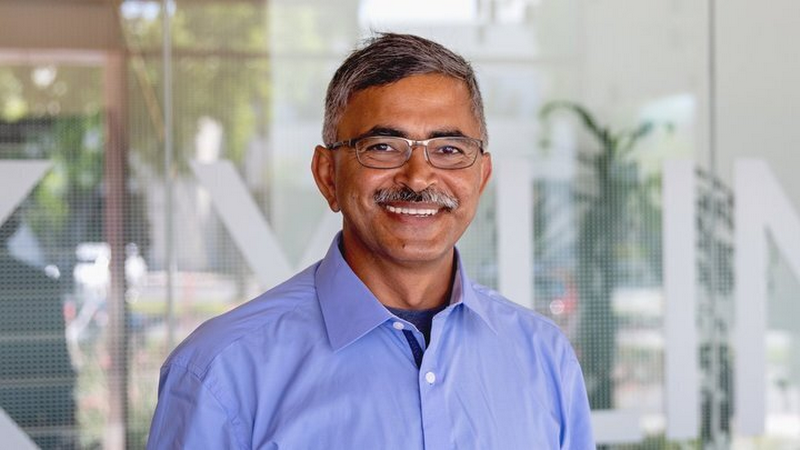In the Clouds with… AMD’s Hasmukh Ranjan: “The most important part is to put on your shoes and show up.”

Matt A.V. Chaban
Senior Editor, Transform
Welcome to our column “In the Clouds with…” We'll be hearing from technology leaders about what keeps them up at night and their secrets to success.


When he became AMD’s CIO in April 2022, Hasmukh Ranjan could hardly have picked a more auspicious time. Just two months prior, the California-based semiconductor maker completed a $49-billion acquisition of Xilinx—where he was CIO—culminating the largest merger in the chip industry’s history. It now falls to Ranjan to integrate and harmonize IT systems, and so much more, for both companies.
In many ways, it’s nothing new for Ranjan, who undertook upwards of 90 mergers during his 23-year tenure at Synopsys, a leader in chip design software. He joined Synopsys straight after earning a masters in computer science at Northeastern University, and worked his way up to the CIO role there before joining Xilinx in 2020. A “meditative runner,” he seems to find inspiration everywhere he goes.
Big Six:
1. What business challenge is keeping you up at night?
The merger between Xilinx and AMD is one of the largest in the semiconductor industry, and what worries me right now is: How do we make sure we align the business processes of two companies in a seamless way? How do we ensure that we continue to improve our employees' productivity in a diverse and distributed environment? And then, while we are doing all that, how do we make sure that we continue to keep our security at the highest level?
After integrating 90-plus companies while at Synopsys, I’ve learned the important factors: One, how do you listen to different stakeholders? Two, how do you make sure that the business alignment and priorities are very clearly defined? And three, how to communicate effectively. There are so many moving parts that need to fall into the right place.
2. How deeply is AMD currently invested in the cloud? What about in five years?
We look at cloud in two ways. First, we contribute to building the cloud by supplying processors, AI engines, FPGAs and all the other cool hardware that companies like Google and other hyperscalers use to build their clouds. Second, we are consumers of cloud computing. We are an engineering company, and we have our own requirements around new architectures, peak needs, and other workloads. In the semiconductor vertical, we may be one of the largest consumers of cloud. As the company continues to scale and grow, we will continue partnering with cloud providers to expand our operations.
3. Tech has always faced talent challenges, both in terms of scarcity and diversity. What's your advice for recruiting top talent in today's climate?
I look at it from two perspectives. Short term, you have to prioritize identifying your own talent and how to retain them. That's as important as getting talent from outside. And for outside hires, I focus on specific needs, fill my leadership roles with those, and then build the broader team around those people.
More important is the long-term view: Are we investing in the internship program? Are we hiring new grads who we can grow into diverse roles? It’s a combination of making sure we have a sustained pool of talent and building something that will last for the long run and not be affected by any talent trends or issues.
4. What's been the most transformational IT initiative you've led to date?
When I started my career in IT, we were all kind of backbenchers. You would go set up some machines or a few laptops or fix and reboot a few systems—that's how it was perceived. Over the years, the value of IT has grown, especially after the pandemic. There’s a newfound respect for IT in every enterprise. Taking that journey, from IT being a cost center to becoming a rightful business partner, is where my efforts, my focus, and my successes have been.
My work at Synopsys was unique from that perspective. It provided opportunities to integrate many environments, including high-performance computing, which was in big demand. We had built a high-performance computing environment, and in 2006, my team had the job of benchmarking it. We ranked in the top 500 supercomputers in the world, I think 242nd, actually. That was a very cool project to handle.
5. Every executive has their “top secrets of success” they know they’ll repeat when taking any new job. What’s yours?
I represent a service organization, so I have to be very, very clear on that role. There are a few things that I am very particular about. First is aligning yourself with the business. You have to be very detailed and show you understand the business. That will help you align your priorities for the company and your own organization.
Second is execution. As a service organization, you have to value commitments. You have to make sure you have committed to people and are delivering on those commitments. Based on our commitments, other teams are lining up their activities so this is critical.
And then relationships. If you don't build strong relationships and partnerships with different business groups, I don't think you'll be successful. Those relationships aren’t just inside the company with employees, but across and outside the company, building relationships with customers and partners.
6. What is the best advice you ever got?
It’s taking that first step. We all get into situations where we think it is an impossible situation, and our natural inclination is to quit. Then every time, once I showed up and took the first step towards solving the problem, the second step, the fifth step, the tenth, everything started to open up. Maybe it’s because I’m a runner, and I go on long runs on the weekend—the most important part is to put on your shoes and show up.
Taking that journey, from IT being a cost center to becoming a rightful business partner, is where my efforts, my focus, and my successes have been.
Dirty Half-Dozen:
1. Book on your nightstand? Never Eat Alone, by Keith Ferrazzi
2. Lunch with a leader living or dead? Warren Buffett—he’s very expensive, though.
3. Favorite way to R&R? That meditative state that comes over you while running.
4. RTO, WFH or Mission to Mars? I’m old school, so RTO
5. Three apps you can’t live without? Calendar, email, The Wall Street Journal.
6. Your motto or mantra? Just show up



